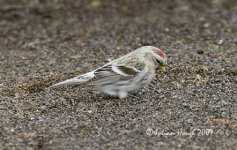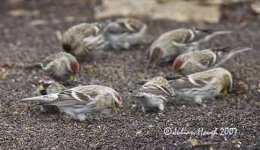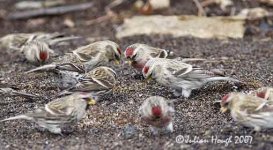With regard to Common(Mealy) and Arctic(Exiples) Redpolls in the field here in Sweden I would say the following...
These birds, both species that is, display a wide degree of individual variation. I have spent a great deal of time studying Mealy Redpoll in particular here over the last three winters, partially due to the fact there is little else to see on many days here in the winter! They are fabulous birds and I will never tire of watching them. Will admit to almost tearing my hair out on several occasions, such is the variability among Mealy Redpoll, though have managed to see at least sixteen Exiples in that time, with many more possibles, some of which I just did not get good enough views of and others I simply had to leave alone, mostly female types. There will always be individuals that may not be identifiable in the field, those that fall into the grey area, so to speak. However I do feel that given good views and careful observation many of these birds can be sorted out if the observer takes an analytical approach in clinching several key pointers that go towards establishing the identification of these birds. Basically a suite of several features will add up to the full picture, whereas reliance on just a couple of more obvious field marks can lead to an inconclusive identification.
When scanning through a Redpoll flock on the deck I find it useful to concentrate mainly on the flanks initially, as well as simultaneously looking for pallid birds that may stand out amongst their Mealy relatives. I use these criteria solely for the reason that generally speaking they work as pointers to interesting individuals in the field under normal viewing conditions. Birds perched overhead may give opportunity to scrutinize the undertail coverts, which is very useful, the problem with overhead birds is that they often fly away! An ideal situation is one where the birds are feeding heavily in an area and are settled there as a result. It should be noted that here in Sweden the situation is different to the UK in that the vast majority of Redpolls are Mealy. Lesser Redpolls do occur here in small numbers,(and are readily identifiable in general) but Mealy is the predominent species from which the others are picked out.
It helps hugely if the bird can be sexed and aged if possible from the start. Any potentially interesting individual that stands out can then then be studied carefully for the following features;
(a)Rump; hopefully extensive clean white rump extending onto lower back! Not always so easy though. Exiples often shows fine pin streaks, particularily female plumages, though the rump should still be rather clean as a rule. Mealy can also display an extensively white rump, though generally only amongst males. Most of these birds will show some fine streaking on close inspection. Further complicated at times by fluffed out plumage, especially in cold conditions, which can conceal streaking and give an 'Exiples' impression. Careful observation over time will reveal any streaks present.
(b)Flanks; a rather useful feature of the large majority of Exiples is reduced flank streaking (in comparison to Mealy) over clean whitish flanks. Streaking is often broken and appearing as a series of isolated marks as the result of reduced dark feather shaft markings. Some show small, isolated dark spots on the breast.Some adult Exiples display completely clean flanks. The vast majority of Mealy's show heavily marked flanks over rather grey/brown smudged flanks. Pale Mealy Redpolls(usually male) may display whitish flanks but usually still remain heavily streaked nevertheless. Variables again occur in Mealy Redpoll, the species can show rather reduced flank streaking, though usually usually still appear as unbroken lines along the flank.
(c)Undertail Covert's; Hopefully snow white! Exiples often displays thin shaft streaks on the undertail however. On males this is often confined to a single streak on the longest undertail covert, with some first winter birds displaying a number of thin streaks. Female Exiples, both adult and in particular First Winter often display thin shaft streaking on the undertail. Mealy Redpolls generally display noticable, often heavy triangulated streaks on the undertail covert shafts, especially females. Rarely Mealy Redpoll displays a clean undertail, often with buff tones. More commonly I have seen males with reduced streaking confined to the longest posterior undertail coverts.
(d) Bill; As mentioned on the thread here Exiples usually shows a smaller bill with a straight edged culmen which makes it appear a lot less bulky than on that of Mealy. Exiples 'facial expression' is often markedly different to Mealy, appearing more gentile, smaller eyed and smaller billed, giving it a subtle difference in jizz in the field. This can be exagerated further by exiples tendency to fluff out its plumage in cold weather, making the face apear proportionally smaller.
(e)Ear Coverts; Exiples shows a diffuse darker border to the ear coverts and paler central area devoild of any markings. Mealy shows more uniform ear covert's often mottled at the centre giving the face an overall darker impression.
(f)Plumage Tones; Exiples often dislays rather cold pale yellow ochre tones around the head, sides of neck and breast, sometimes also on the back. Exiples also has a tendency to appear paler on the scapulars, particularily the lower scaps.(Often on male birds) Mealy generally shows dirty brown tones in the plumage, often extensive and striking white braces on the mantle which can vary in extent. Pale Mealy's are not unusual but the individuals I have seen have looked just that, rather pale, white washed versions of the 'standard Mealy without he yellow ochre tones observed on Exiples. Often these birds display clean white underparts which are rather toneless, yet retain the heavy flank streaks that seem a very good indicator of Mealy Redpoll.
(g) Tail Feathers;Very hard to establish, but given good views at fairly close range First Winter Exiples has pointed feather tips, with fresher fringes. Mealy has rounded, often worn fringes at the tail tips. not sure why, assume there is a different moult strategy among the species?(Perhaps someone out there can comment on this?)
(h)Tarsi Feathering; Exiples has rather heavily feathered tarsi in all plumages, presumably an adaptation to life in colder climes.
I respect that I have only have to deal with Mealy, Exiples Arctic and Lesser Redpolls here in Stockholm and that if one were birding the Northern Isles of Scotland the situation may well be more complex with Icelandic and Hoary Arctic birds to consider. I do think though that given good, lengthy views and a degree of care most birds should be identifiable. A familiarity with Mealy Redpoll is of course a huge aid to identifying Exiples Arctics, luckily for me Mealy is not in short supply here in Sweden, though the case is very different in the UK for example, so if one turns up near you, go have a look, you won't regret it!(cracking birds they are!)
Having said all that I will say that no doubt at some point in the near future I might well be seen tearing my hair out beside a sunflower bed here in Stockholm, part of the deal with Redpolls is that they are a real challenge and are likely to stay that way for a long time yet...







